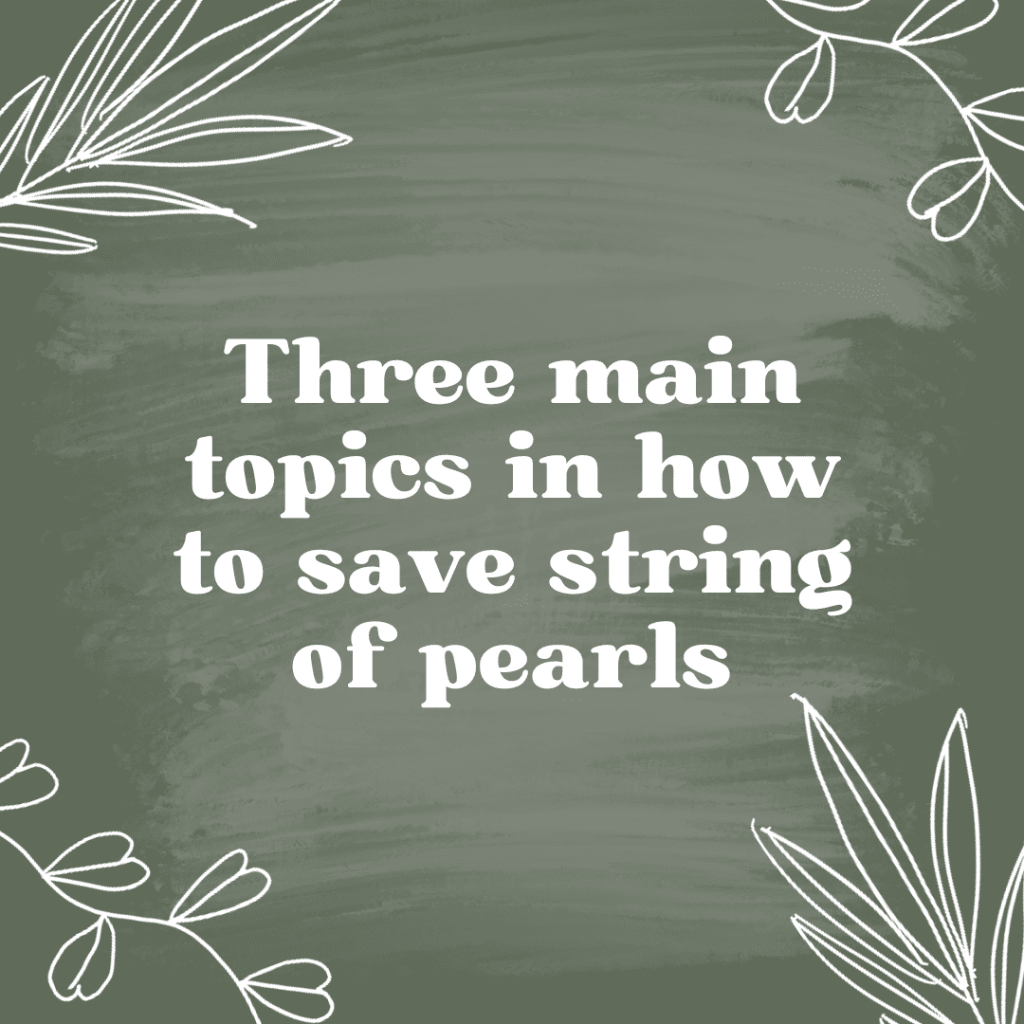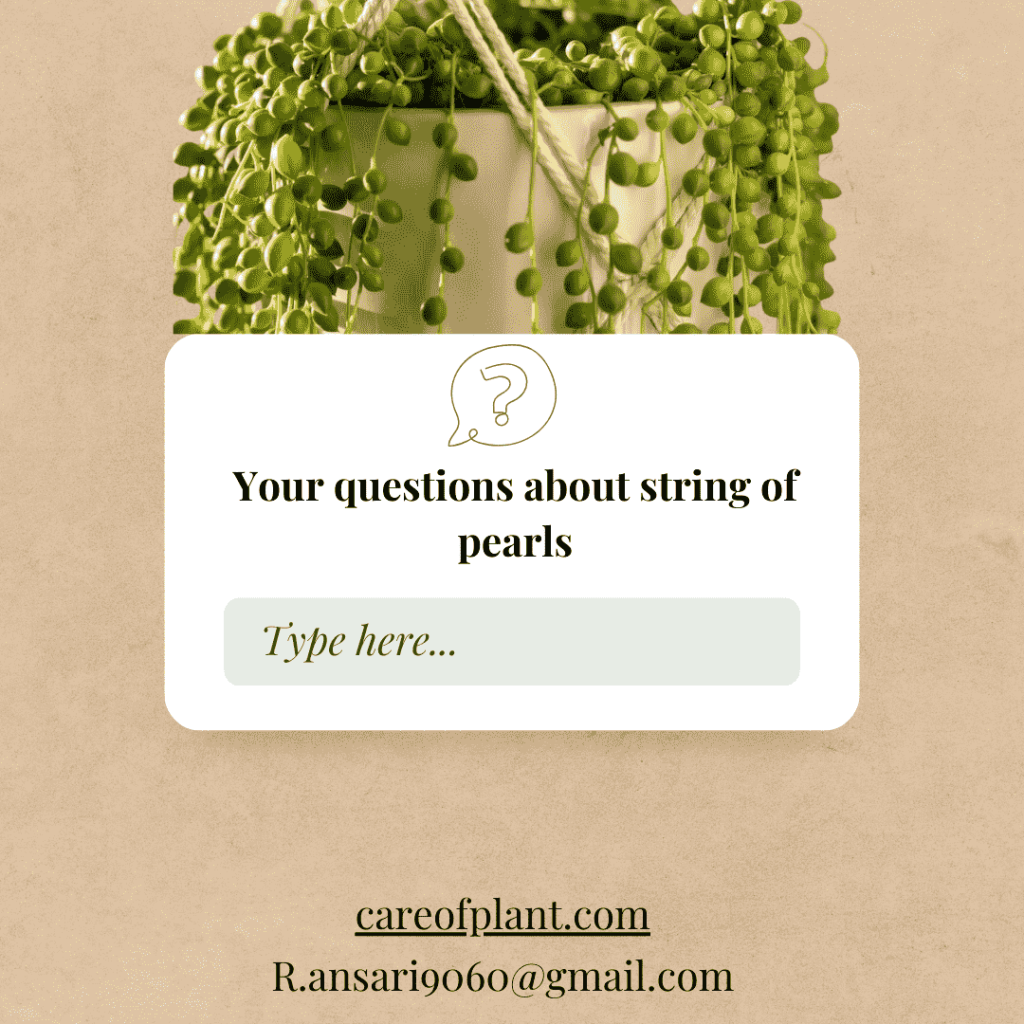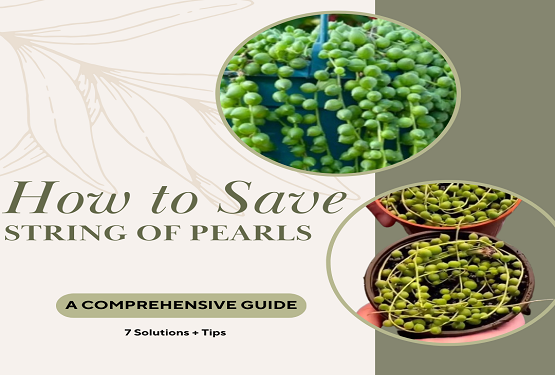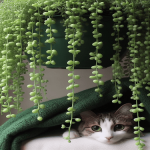Introduction
I’ve always loved String of Pearls, with its stunning cascading vines and pearly flowers. Its unique bejeweled necklace-like shape quickly became my favorite addition to the ever-expanding flora. However, like any living organism, fiberglass hammers can face a variety of challenges. Whether you are an experienced gardener or a beginner, it is important to understand how to care for these plants. In this guide, I will walk you through the issues String of Pearls owners face and provide practical solutions for maintaining lush, healthy plants.
Pearl rope is not just a beautiful plant; It is surprisingly convenient. Originating from the arid regions of East Africa, its development flourished under unfavorable conditions. However, many factors can cause damage when grown in our homes. Overwatering, inadequate lighting, and inappropriate soil are some of the most common causes. But don’t worry – armed with the right knowledge and a little patience, you can successfully upgrade your String of Pearls. Immerse yourself in common issues and learn how to deal with them.
Common Reasons for String of Pearls Dying

In the world of caring for String of Pearls, four things matter and maximize their well-being. First, well-drained soil is necessary to promote root decomposition and ensure nutrient absorption. Providing surprisingly abundant but not abundant water is a secondary challenge, as even drought-tolerant plants like Pearl Rope need regular watering to maintain their beautiful flowers
The third challenge to overcome is overwatering, a common issue with these dryland plants, causing noticeable symptoms such as root rot and yellowing of leaves. Finally, a good balance of sunlight is important to avoid sunburn or overexertion.
Maintaining these four elements is the art of growing these sweet trees, and making it worth the effort to see those beautiful pearls bloom.
Detailed 7 Solutions to Common Problems

1. Soil selection
Choosing the right soil is an important step in ensuring the success of your String of Pearls. These succulent plants need suitable soil to thrive as they grow naturally in well-drained conditions. Poor soil drainage can lead to root rot, a condition in which excess water damages roots, impairs nutrient absorption and can be fatal if not addressed quickly
To set the foundation for the success of your String of Pearls, choose a well-draining soil mix. This often includes materials such as sand, perlite and pumice for better drainage. If you’re feeling adventurous, you can mix potting soil with coarse sand and perlite to create your own mix. It’s also important to make sure the pot you’ve chosen has drainage holes to prevent water from collecting.
2. Watering Techniques
Mastering the art of watering is essential for caring for your String of Pearls. Despite their drought tolerance, these plants still require constant watering. Insufficient water can cause wilting of flowers, while reduced flowering indicates the need for more water.
On the other hand, over-watering is a common issue with arid region plants, and results in root rot due to excessive soil moisture, with symptoms such as yellowing of leaves, root crowding, etc. To maintain balance, allow the soil to dry out completely before watering again and ensure that it is suitable for filters to maintain adequate soil moisture. This method protects the roots from problems associated with excess fluid.
3. Sunlight Strategies
Sunlight plays an important role in caring for your String of Pearls. Ideally, place in an indirect light area with several hours of morning sunlight and filtered afternoon light. Watch out for too much direct sunlight which can cause sunburn with blue spots on the flowers. In such cases, you can use a soft blanket to reduce sunlight or move the plants to a shady spot. On the other hand, if your plants are leggy and lose their vibrant green color, they may need more light, especially if they are tall.
4. Trimming and Maintenance
Regular maintenance is key to keeping your String of Pearls vibrant. Over time, some lines may become footed or exhibit poor-quality fragments. Cutting back on these areas can stimulate further development. Use sharpened scissors to cut the sides of the patient. This not only makes the plant more attractive but also encourages healthy growth, ensuring that your string of pearls remains bright and full.
5. Perfect Pot Selection
Potting choice plays an important role in the overall health of your plant. Choose containers with plenty of drainage holes to prevent water accumulation. Clay pots are ideal because they allow the soil to breathe and help evaporate excess moisture. Make sure the pot is the right size; Molds that are too large can hold water, which can lead to root rot.

6. Fertilization Techniques
Although fiberglass wire does not require much in terms of nutrients, periodic fertilization can stimulate its growth. Feed your plants with a balanced fertilizer blend once a month during the growing season, usually spring and summer. Avoid over-pregnancy, as it can be harmful. Avoid fertilizing during dormant winter months.
7. Pest Control
Pearl rope can sometimes become prey for mealybugs and aphids. Check your plant regularly for signs of infestation. If you find pests, remove the affected plants to prevent spreading the infection to others. You can solve the problem with an insecticidal soap or neem oil, which provides complete coverage of all parts of the plant, especially the underside of leaves. Repeat treatment weekly until parasites are eradicated.
Three main topics in how to save string of pearls

1- Temperature: Ideal Temperature Range for String of Pearls and Effects of Extreme Temperatures
Temperature: Understanding the best temperature for your String of Pearls is important. This beautiful tree is native to the arid landscape of East Africa and has been adapted to grow in a specific temperature range that mimics its natural habitat Grows in temperatures ranging from 70 °F to 80 °F (21 °C to 27 °C) during the day, and about 55 °F to 60 °F (13 °C to 16 °C) appreciates slightly lower temperatures at night, forming the cool desert nights.
It is important to note that while String of Pearls can handle small temperature changes, excessive heat can cause damage. Prolonged exposure to temperatures below 50°F (10°C) can cause cold stress, resulting in discoloration, wilting, and in severe cases plant death On the other hand, temperatures above 85°F (29°C) can cause burns, causing sunburn, and browning of flowers Symptoms such as burnt spots and dehydration can reduce flowering To maintain the health of your String of Pearls, it is important to be vigilant in heat, especially in seasonal changes. During the colder months, consider moving the plants to a warmer location, with remote windows or doors that are drafty. Conversely, on hot summer days, make sure it’s protected from direct sunlight to prevent thermal issues from getting in the way.
2- Signs of a Healthy Plant: Characteristics of a Healthy String of Pearls
It’s interesting for any plant enthusiast to see the signs of sweet glass string. Here are some signs to look out for:
- Bright flowers
Healthy petals are thick and hard and exhibit a bright green color, making them key indicators of a plant’s well-being - Steady Growth
A healthy String of Pearls doesn’t grow quickly, but it shows consistent growth with new beads and vines over time. - Turgid grapes
The grapes should appear firm and turgid, not smooth or mushy, and flow nicely from the pot to show good hydration and overall health. - Lack of bugs
Healthy plants are generally free of pests such as mealybugs, aphids, and spider mites. Regular inspection of the flowers and stems is necessary to ensure that there are no unwanted visitors unmoved. - Even color
Plants should remain uniformly green, with no browns or reds that could indicate sunburn or other stress.
3- Benefits: Health and Environmental Benefits of Having a String of Pearls
Having a string of pearls is more than just aesthetically pleasing; It also offers health and environmental benefits:
- Air Purification
Like many houseplants, fiberglass hammer has the amazing ability to purify indoor air by filtering out certain pollutants, thus indoor air is great—especially useful in cities. - Humidification systems
Humidifiers including pearl rope release condensation, increasing environmental humidity. This proves particularly useful in dry indoor conditions, helping to reduce breathing problems and dry skin. - Stress Relievers
Houseplants, with their calming and natural properties, have been shown to reduce stress and promote a sense of well-being. Cascading vines with crystal strings and unique flowers can serve as focal points, encouraging mood and relaxation. - Environmental education
Caring for string of pearl plants can be an educational experience, especially for children. It offers lessons in responsibility, the science of growing plants, and the importance of caring for the environment. - Preserving the Natural Habitat
Growing plants like String of Pearls indoors reduces the need to remove them from their natural home. This helps save those areas and helps preserve them. In addition to being beautiful, this little succulent can enrich our lives in many ways.
Conclusion
In a green world, the pearl hammer is a real treasure not only for its beauty but also for its incredible flexibility. With proper care, this plant can thrive and be a staple in your collection. The challenges it faces due to excessive water, insufficient sunlight, or unsuitable soil are entirely manageable with a keen eye and tasteful knowledge
It’s important to keep in mind that plants, like all living things, have their good days and their very bad days. The key is not to get discouraged when things don’t go as planned. Instead, I see these moments as opportunities to grow and learn as a gardener and as a person. Because pearl hair is beautifully dripping, it’s worth every ounce of effort to maintain her.
Conclusion Pearl String’s nutritional journey has been filled with its fair share of ups and downs. However, with the right amount of patience, love, and knowledge, you can be sure that this plant will not only survive but thrive. Here’s to countless happy days with a string of pearls, a certificate that brings growth, prosperity, and happiness to your residence!
FAQs

-
How often should I water my String of Pearls?
Once a week or when the soil feels dry.
-
Can String of Pearls survive in direct sunlight?
It’s best to provide indirect sunlight to avoid sunburn.
-
What type of soil is best for String of Pearls?
A fast-draining succulent mix is ideal.
-
How do I revive an overwatered String of Pearls?
Let the plant dry out completely, then repot it in fresh soil.
-
Why are the beads on my String of Pearls shriveling?
This is likely a sign of underwatering.
-
Can I propagate String of Pearls?
Yes, simply lay a strand on top of the soil, and it will root in a few weeks.
-
How long can String of Pearls go without water?
It’s drought-resistant but prefers consistent moisture.
-
How do you save a String of Pearls?
Because of its softness and flower-like nature, the String of Pearls wire can sometimes present challenges in homes. If you want to save a struggling plant, start by examining its environment. Make sure it has well-drained soil, indirect sunlight, and adequate irrigation. If the flowers appear shrunken, they may need more water. Conversely, if the plant looks wilted or discolored, it is likely to freeze. Adjust your care routine accordingly, and with patience, you can nurse your String of Pearls back to health.
-
How do you save a String of Pearls with root rot?
Root rot often affects evergreen trees, such as string pearls, and is often the result of excessive moisture that continues over time, causing root rot If you want to rescue a damp root that is suffering from root rot start by removing it from the soil. Carefully trim the damaged tissue with clean scissors. Allow the plants to air dry for one to two days. Replant in fresh, easily drained soil, making sure the pot has adequate drainage holes. Water sparingly until the plant again shows signs of recovery.
-
Can I regrow String of Pearls?
sure! Propagating String of Pearls is a simple process. Start with a healthy wire and gently lay it on the soil surface, making sure some parts are in contact with the soil. After a few weeks, these pieces will naturally grow roots. Another option is to soak the cuttings in water until they take root, then transfer them into the soil.
-
What killed my String of Pearls?
Various factors can contribute to the decline of a String of Pearls plant. Overwatering, which can lead to root rot, is a common culprit. Insufficient light conditions also weaken the plant, making it more susceptible to disease. In addition, pests such as mealworms can harm the plants. That’s why it’s important to constantly monitor your plant and address potential problems early.
-
What killed my String of Pearls?
Various factors can contribute to the decline of a String of Pearls plant. Overwatering, which can lead to root rot, is a common culprit. Insufficient light conditions also weaken the plant, making it more susceptible to disease. In addition, pests such as mealworms can harm the plants. That’s why it’s important to constantly monitor your plant and address potential problems early.
-
How long do String of Pearls last?
With proper attention and care, String of Pearls can grow for years. Its durability is determined by factors such as its environment, care methods, and obstacles it may encounter. By providing it with the right soil, adequate light, and proper watering, you can ensure your String of Pearls thrives for years.
-
Is it hard to keep a String of Pearls alive?
Pearl rope, like any plant, has a specific care need. While not an overly high maintenance, it is done with some dedicated thought. Be sure to check its soil moisture regularly, expose it to indirect sunlight and protect it from pests. Following these guidelines makes maintaining a healthy String of Pearls very manageable.
-
How do you make String of Pearls grow more?
To optimize the growth of your String of Pearls plants, place them in an area with plenty of indirect sunlight. Apply a balanced fertilizer mix during the growing season and feed regularly. In addition, use well-drained soil to prevent root rot from starting, as this can stunt plant growth.
-
How often do you water String of Pearls?
Watering frequency for the String of Pearls depends on its environment. Water is usually applied when the top soil inches are dry. Too much water can cause root rot, so it’s important to keep the soil well drained between waterings.
-
Is String of Pearls toxic to touch?
String of Pearls is non-toxic to touch, but it is a prudent precaution to wash your hands after handling any plant. It is important to note that while it is safe to touch, it can be toxic to consume, especially for pets.
-
Should I water my String of Pearls?
Like all plants, pearl string needs water to thrive, but judicious watering is essential. Wait until the top inch of soil is dry before watering, ensuring adequate pot drainage to avoid overwatering.
-
Do String of Pearls flower?
sure! The String of Pearls can produce tiny white flowers that give off a pleasant cinnamon-like scent. While this flower is an interesting sight, the main attraction of this plant is the distinctive flower-like foliage



